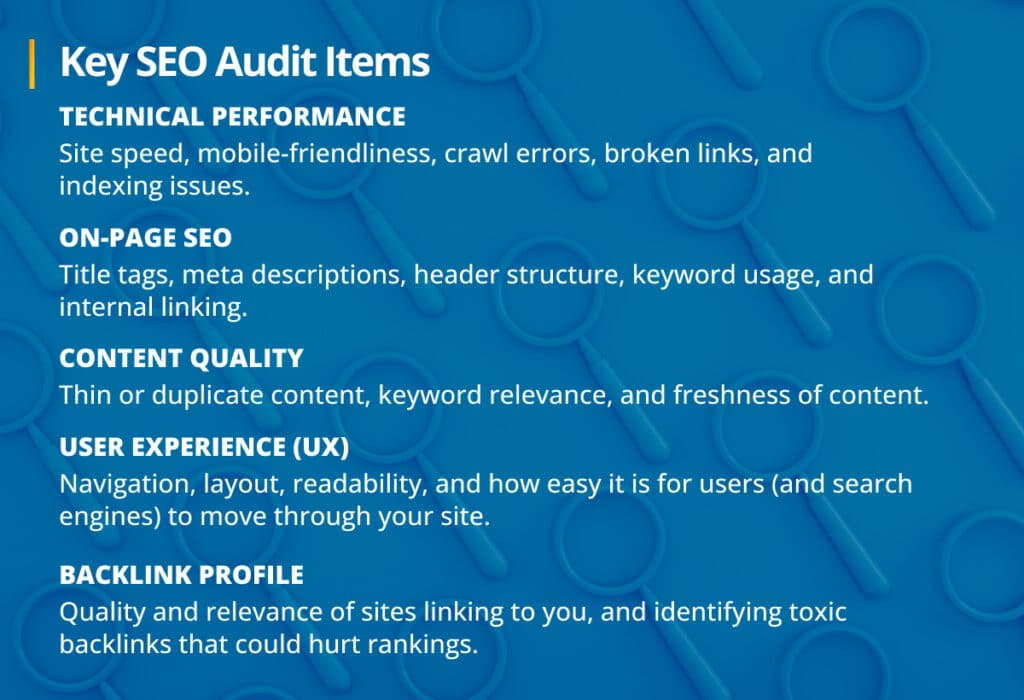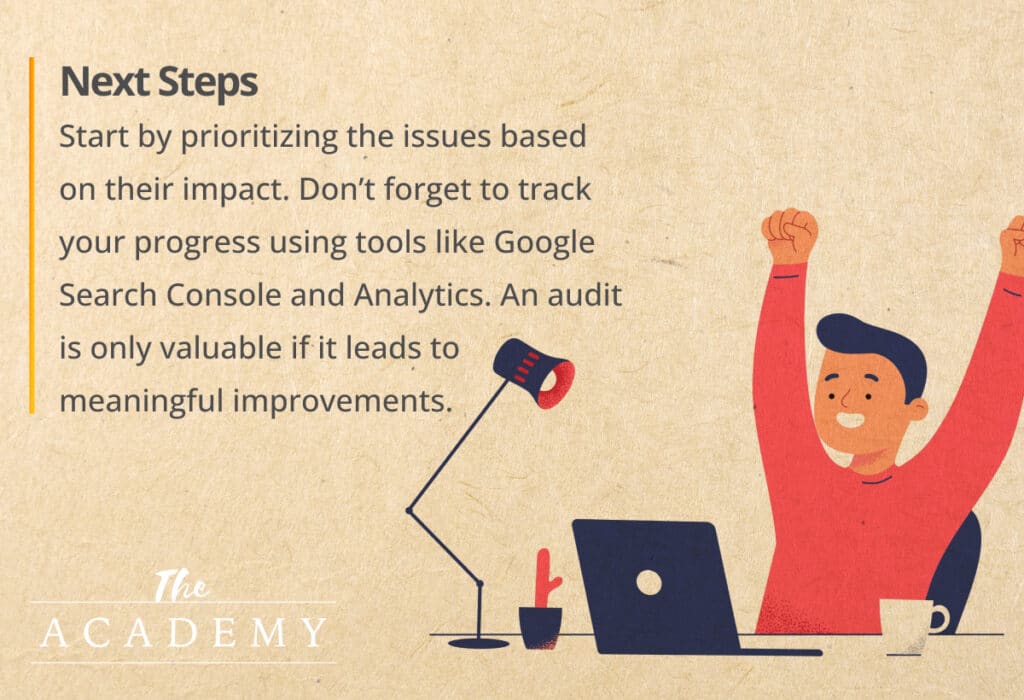
An SEO audit is a great way to do a deep dive into the health of your website. It helps identify what’s holding your site back in search rankings by checking everything from technical issues and on-page SEO to site structure and content quality. Learn more about SEO audits and their importance in this blog.
SEO Audits Overview
An SEO site audit helps to uncover what’s working, what’s broken on your site, and what can be improved to boost visibility in search engines. Regularly auditing your site ensures it’s running smoothly and ranking where it should. Whether you’re trying to climb higher in Google results or just want to make sure you’re not leaving traffic on the table, an SEO audit is where it all starts.
Here are some key things an SEO audit looks at:
- Technical performance: Site speed, mobile-friendliness, crawl errors, broken links, and indexing issues.
- On-page SEO: Title tags, meta descriptions, header structure, keyword usage, and internal linking.
- Content quality: Thin or duplicate content, keyword relevance, and freshness of content.
- User experience (UX): Navigation, layout, readability, and how easy it is for users (and search engines) to move through your site.
- Backlink profile: Quality and relevance of sites linking to you, and identifying toxic backlinks that could hurt rankings.
Once the audit is complete, it’s not just about spotting issues—it’s about turning insights into action. A good SEO audit gives you a clear roadmap for what to prioritize, whether it’s fixing broken links, improving site speed, or rewriting outdated content. It can also help you uncover opportunities, like keywords you’re almost ranking for or pages that could benefit from better internal linking. The real value comes from using the data to make smarter decisions that lead to better rankings, more traffic, and ultimately, a stronger online presence.
Key Areas to Focus On During an SEO Audit
When running an SEO audit, knowing where to focus can make all the difference. By zeroing in on the areas that impact visibility, performance, and user experience, you can quickly spot what’s holding your site back and what needs attention first.
Here are a few things to look out for:

1. Technical SEO Issues
- Site speed: Slow-loading pages can hurt rankings and user experience.
- Mobile-friendliness: Ensure your site works well on all devices.
- Crawlability: Check if search engines can access and index your pages properly.
- Broken links / 404 errors: These hurt UX and SEO.
- Redirects: Make sure redirects (especially 301s) are properly set up.
- HTTPS status: Secure sites (with SSL) are preferred by Google.
2. On-Page SEO
- Title tags & meta descriptions: Are they unique, optimized, and compelling?
- Header tags (H1, H2, etc.): Proper structure helps both users and search engines.
- Keyword usage: Are keywords used naturally and effectively on each page?
- Alt text for images: Important for image SEO and accessibility.
3. Content Quality
- Thin or duplicate content: Google prefers rich, original content.
- Content relevance: Does the content match user intent?
- Content freshness: Outdated content may need a refresh or removal.
4. Internal & External Links
- Internal linking structure: Helps with navigation and distributing authority.
- Backlink profile: Are you earning quality, relevant backlinks? Any spammy ones?
5. User Experience (UX)
- Navigation & site structure: Easy-to-use structure boosts both SEO and UX.
- Core Web Vitals: Includes metrics like Largest Contentful Paint (LCP), First Input Delay (FID), and Cumulative Layout Shift (CLS).
6. Analytics & Tracking
- Google Analytics & Search Console setup: Make sure everything is connected and tracking properly.
- Goal tracking: Are conversions, events, or key actions being monitored?
Next Steps from Your SEO Audit

Once you’ve completed an SEO audit, the next step is turning insights into action. Start by prioritizing the issues based on their impact—fixing high-priority technical problems, like broken links or slow load times, should come first. Then, focus on optimizing on-page elements like title tags, meta descriptions, and internal links. Use content findings to update or remove outdated pages and create opportunities for new content where gaps exist. Don’t forget to track your progress using tools like Google Search Console and Analytics. An audit is only valuable if it leads to meaningful improvements, so think of it as your game plan for better rankings and a smoother user experience.
Turn Your SEO Audit Into Action
An SEO audit is one of the most powerful tools for uncovering hidden issues and unlocking your site’s full potential. From technical fixes to content improvements, it gives you a clear path to better visibility, higher rankings, and a smoother user experience. But the real impact comes from taking action. Don’t let your audit findings sit in a spreadsheet—start making changes, track your progress, and keep optimizing. Ready to boost your site’s performance? Dive into your own SEO audit or reach out for expert help to get started.
Most Popular Articles

Seeing Favicons in Your Google Search Results? Here’s Why…
Have you noticed anything different in your Google Search results lately? Google added tiny favicon icons to its organic search results in January. It was…

Business Growth and Digital Marketing News & Tips 11-17-24
Are you encouraging and rewarding innovation? Lee Cockerell is the former Executive Vice President of Operations at Walt Disney World. A lover of traditional red…

Business Growth and Digital Marketing News & Tips 11-27-24
A culture of gratitude "Feeling gratitude and not expressing it is like wrapping a present and not giving it." – William Arthur Ward Beyond being…








